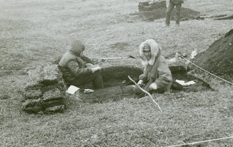Ipiutak Site
|
Ipiutak Site
|
|

Excavating the Ipiutak site
|
|
| Nearest city | Point Hope, Alaska |
|---|---|
| Coordinates | 68°20′35″N 166°49′20″W / 68.34306°N 166.82222°WCoordinates: 68°20′35″N 166°49′20″W / 68.34306°N 166.82222°W |
| NRHP Reference # | 66000157 |
| Significant dates | |
| Added to NRHP | October 15, 1966 |
| Designated NHL | January 20, 1961 |
The Ipiutak Site is a large archaeological site at Point Hope in northwest Alaska.
It is the type site for the Ipiutak culture, which arose possibly as early as 100–200 BCE and collapsed around 800 CE. The Ipiutak culture occurred from south of the Bering Strait, across the Brooks Range and possibly as far north as Point Barrow.
The Ipiutak site was discovered in 1939 by archaeologists Helge Larsen and Froelich Rainey, who completed a monograph on the site in 1948. The site consists of nearly 600 abandoned house depressions along four beach ridges that impart a linearity that was originally interpreted as purposeful design as roads or "avenues." Many of the houses are too close to be contemporaneous and the range of several radiocarbon ages suggests a duration of 300–400 years to build all of the houses. Archaeologists have modeled the population history of the site to infer that only about 125–200 people lived at the site during any one generation and occupied 20 to 30 houses. The original population estimates of over 4000 are in error.
Excavations in 1940 and 1941 produced sizable collections from 74 square driftwood constructed houses and over 120 burials, now archived within three museums: the National Museum of Denmark, the American Museum of Natural History and the University of Alaska Fairbanks.
The site is renowned for its mortuary offerings, one of which is termed a "mask." One Point Hope Ipiutak mask represents a human face with a gaping mouth and blowfly larvae issuing from its nostrils; a symbol pregnant with shamanistic meaning. A very similar "maskoid" is reported from Deering, that is dated between 600 and 800 CE. A variety of open work ivory carvings, engraved with iron burins, are renowned for their figurative representations that include polar bears, loons, seals, and (rarely) humans. Ipiutak houses contain evidence of military and craft specialization in working walrus tusk, while a number of graves show evidence of violence associated with warfare.
...
Wikipedia

